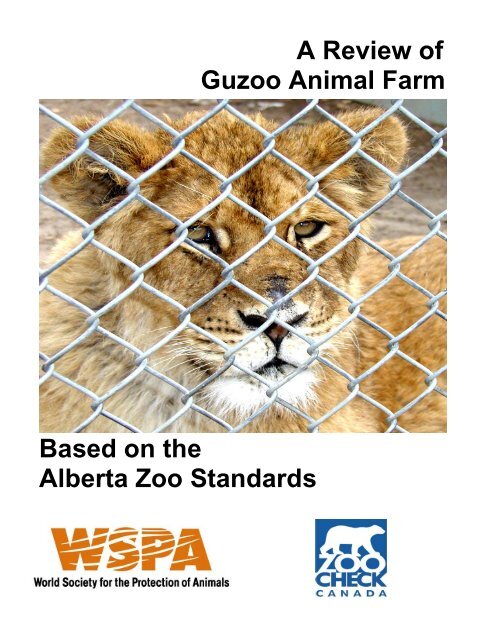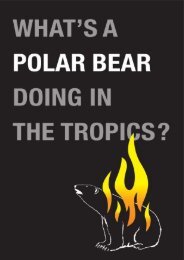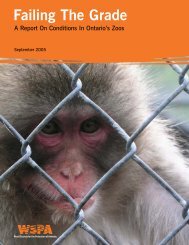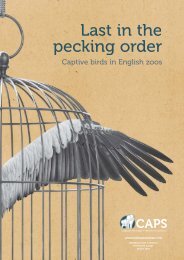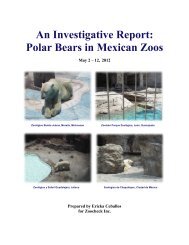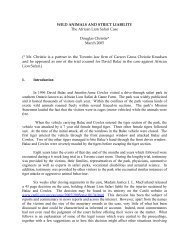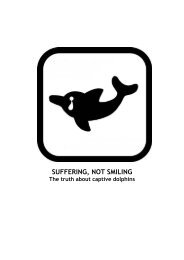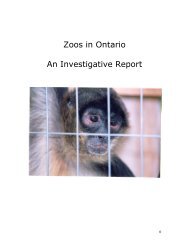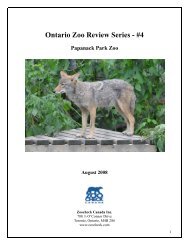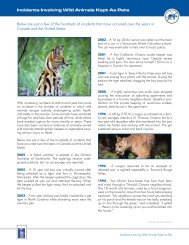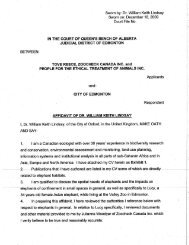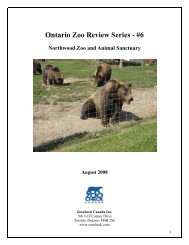A review of Guzoo Animal Farm Based on the - Zoocheck Canada
A review of Guzoo Animal Farm Based on the - Zoocheck Canada
A review of Guzoo Animal Farm Based on the - Zoocheck Canada
Create successful ePaper yourself
Turn your PDF publications into a flip-book with our unique Google optimized e-Paper software.
<str<strong>on</strong>g>Based</str<strong>on</strong>g> <strong>on</strong> <strong>the</strong><br />
Alberta Zoo Standards<br />
A Review <str<strong>on</strong>g>of</str<strong>on</strong>g><br />
<str<strong>on</strong>g>Guzoo</str<strong>on</strong>g> <str<strong>on</strong>g>Animal</str<strong>on</strong>g> <str<strong>on</strong>g>Farm</str<strong>on</strong>g>
Introducti<strong>on</strong><br />
<strong>Zoocheck</strong> <strong>Canada</strong> is a nati<strong>on</strong>al animal welfare charity established in 1984 to promote <strong>the</strong><br />
interests <str<strong>on</strong>g>of</str<strong>on</strong>g> wildlife in captivity and in <strong>the</strong> wild. For <strong>the</strong> past twenty years, <strong>Zoocheck</strong> has carried<br />
out assessments <str<strong>on</strong>g>of</str<strong>on</strong>g> captive wildlife husbandry and housing c<strong>on</strong>diti<strong>on</strong>s in a wide range <str<strong>on</strong>g>of</str<strong>on</strong>g><br />
facilities; evaluated and addressed public safety and security issues related to wildlife in captivity;<br />
and evaluated <strong>the</strong> effectiveness <str<strong>on</strong>g>of</str<strong>on</strong>g> live animal-based educati<strong>on</strong> and c<strong>on</strong>servati<strong>on</strong> programming.<br />
The World Society for <strong>the</strong> Protecti<strong>on</strong> <str<strong>on</strong>g>of</str<strong>on</strong>g> <str<strong>on</strong>g>Animal</str<strong>on</strong>g>s (WSPA) is an animal welfare charity that works<br />
internati<strong>on</strong>ally and locally to end cruelty to animals through field work, campaigning, and<br />
educati<strong>on</strong>. WSPA is <strong>the</strong> world’s largest federati<strong>on</strong> <str<strong>on</strong>g>of</str<strong>on</strong>g> humane societies and animal protecti<strong>on</strong><br />
organizati<strong>on</strong>s, representing over 802 member societies in more than 147 countries.<br />
<strong>Zoocheck</strong> and WSPA have been m<strong>on</strong>itoring <strong>the</strong> c<strong>on</strong>diti<strong>on</strong>s in zoos across <strong>Canada</strong> for many<br />
years. <str<strong>on</strong>g>Guzoo</str<strong>on</strong>g> <str<strong>on</strong>g>Animal</str<strong>on</strong>g> <str<strong>on</strong>g>Farm</str<strong>on</strong>g> (<str<strong>on</strong>g>Guzoo</str<strong>on</strong>g>) near Three Hills, Alberta has been a c<strong>on</strong>cern to both<br />
organizati<strong>on</strong>s for several years due to its substandard animal husbandry c<strong>on</strong>diti<strong>on</strong>s and safety<br />
practices. <strong>Zoocheck</strong> and WSPA have documented many <str<strong>on</strong>g>of</str<strong>on</strong>g> <strong>the</strong>se c<strong>on</strong>cerns in a variety <str<strong>on</strong>g>of</str<strong>on</strong>g> reports<br />
and papers. In resp<strong>on</strong>se to those c<strong>on</strong>cerns, both groups worked diligently to assist <strong>the</strong> province<br />
to develop standards to deal with <strong>the</strong> problems at <str<strong>on</strong>g>Guzoo</str<strong>on</strong>g> and o<strong>the</strong>r substandard facilities in <strong>the</strong><br />
province.<br />
In 2005, <strong>the</strong> Alberta government finalized standards for zoos in Alberta with a stated purpose “to<br />
ensure that facilities requiring an Alberta Zoo Permit meet acceptable standards that provide: a<br />
suitable envir<strong>on</strong>ment for <strong>the</strong> animal collecti<strong>on</strong>s and visitors; an envir<strong>on</strong>ment that emphasizes<br />
educati<strong>on</strong>; where <str<strong>on</strong>g>of</str<strong>on</strong>g>f-site display occur, <strong>the</strong>re is minimum risk to surrounding free-ranging wildlife,<br />
domestic animals and people, and in some cases provide an opportunity for scientific research<br />
and animal propagati<strong>on</strong> to support wildlife c<strong>on</strong>servati<strong>on</strong> programs.”<br />
The Alberta Government announced <strong>the</strong> new zoo standards in October 2005. The standards<br />
came into effect <strong>on</strong> April 1 st 2006 and zoos were given until October 2006 to comply. Now, more<br />
than <strong>on</strong>e year after <strong>the</strong> standards were introduced, <strong>Zoocheck</strong> and WSPA have c<strong>on</strong>ducted an<br />
inspecti<strong>on</strong> <str<strong>on</strong>g>of</str<strong>on</strong>g> <str<strong>on</strong>g>Guzoo</str<strong>on</strong>g> to assess <strong>the</strong>ir compliance with <strong>the</strong>se new regulatory requirements. This<br />
report is a summary <str<strong>on</strong>g>of</str<strong>on</strong>g> violati<strong>on</strong>s that we observed during a visit to <str<strong>on</strong>g>Guzoo</str<strong>on</strong>g> <str<strong>on</strong>g>Animal</str<strong>on</strong>g> <str<strong>on</strong>g>Farm</str<strong>on</strong>g> <strong>on</strong> July<br />
11, 2007. Photographs have been included showing many <str<strong>on</strong>g>of</str<strong>on</strong>g> <strong>the</strong> violati<strong>on</strong>s.<br />
<strong>Zoocheck</strong> and WSPA have produced this report to highlight <strong>the</strong> <strong>on</strong>going and unresolved<br />
problems at <str<strong>on</strong>g>Guzoo</str<strong>on</strong>g> <str<strong>on</strong>g>Animal</str<strong>on</strong>g> <str<strong>on</strong>g>Farm</str<strong>on</strong>g>. The Government <str<strong>on</strong>g>of</str<strong>on</strong>g> Alberta should, in <strong>the</strong> interests <str<strong>on</strong>g>of</str<strong>on</strong>g> both<br />
animal welfare and public safety, move to enforce <strong>the</strong> Alberta zoo standards to <strong>the</strong> full extent <str<strong>on</strong>g>of</str<strong>on</strong>g><br />
<strong>the</strong> law. If <str<strong>on</strong>g>Guzoo</str<strong>on</strong>g> is unable to come into compliance with provincial law after all this time, it may<br />
be time to revoke <strong>the</strong> zoo license and relocate <strong>the</strong> animals.<br />
1
<str<strong>on</strong>g>Animal</str<strong>on</strong>g> Care and C<strong>on</strong>finement<br />
The stated purpose <str<strong>on</strong>g>of</str<strong>on</strong>g> <strong>the</strong> animal exhibit standards is “to ensure <strong>the</strong> exhibits meet <strong>the</strong> needs <str<strong>on</strong>g>of</str<strong>on</strong>g><br />
<strong>the</strong> animals that will occupy <strong>the</strong>m” and yet <strong>the</strong> animals at <str<strong>on</strong>g>Guzoo</str<strong>on</strong>g> c<strong>on</strong>tinue to live in impoverished<br />
enclosures with lack <str<strong>on</strong>g>of</str<strong>on</strong>g> fresh and appropriate food and water.<br />
Food & Water: Secti<strong>on</strong> III. E. General <str<strong>on</strong>g>Animal</str<strong>on</strong>g> Care Standards states that “<str<strong>on</strong>g>Animal</str<strong>on</strong>g>s must be<br />
provided with nutritious food as set out in <strong>the</strong> veterinary written agreement and a potable water<br />
source must be available to all animals at all times” and “Feeding and watering c<strong>on</strong>tainers must<br />
be kept clean and self-feeders and watering devices must be checked daily.”<br />
Since <strong>the</strong> Alberta government chose not to provide us with a copy <str<strong>on</strong>g>of</str<strong>on</strong>g> <str<strong>on</strong>g>Guzoo</str<strong>on</strong>g>’s development plan,<br />
which would include <strong>the</strong> veterinary written agreement, which outlines <strong>the</strong> recommended diet for<br />
<strong>the</strong> animals, compliance with <strong>the</strong> diet secti<strong>on</strong> <str<strong>on</strong>g>of</str<strong>on</strong>g> <strong>the</strong> standards cannot be determined. However,<br />
“rotting” carcasses were observed in both <strong>the</strong> li<strong>on</strong> and tiger enclosures.<br />
Unclean water was observed in a number <str<strong>on</strong>g>of</str<strong>on</strong>g> <strong>the</strong> animal enclosures including <strong>the</strong> capybara,<br />
Siberian lynx, tiger, li<strong>on</strong>, goat and pig enclosures.<br />
Filthy water in lynx enclosure Water in capybara enclosure Green water in li<strong>on</strong> enclosure<br />
Rancid water in tiger pool<br />
2
Cleanliness <str<strong>on</strong>g>of</str<strong>on</strong>g> cages: Secti<strong>on</strong> III. E. General <str<strong>on</strong>g>Animal</str<strong>on</strong>g> Care Standards states that “Buildings and<br />
substrates to which animals have access must be kept clean as follows:<br />
• Washable surfaces must be washed clean and disinfected regularly to prevent potentially<br />
dangerous accumulati<strong>on</strong>s <str<strong>on</strong>g>of</str<strong>on</strong>g> organic and inorganic materials and organisms.<br />
• Substrates which cannot be washed must be cleaned <str<strong>on</strong>g>of</str<strong>on</strong>g> gross waste (e.g., perishable<br />
food and animal waste) <strong>on</strong> a daily basis (enclosures smaller than 0.5 acres) and less<br />
frequently for larger enclosures. The animal care protocol may indicate l<strong>on</strong>ger cleaning<br />
intervals for some species to reduce psychological stress. To facilitate cleaning all areas<br />
<str<strong>on</strong>g>of</str<strong>on</strong>g> <strong>the</strong> enclosures must be accessible to keepers.<br />
• Substrates such as loose bedding material must be changed if soiled with feces and urine<br />
and any bedding provided must be kept dry and changed <strong>on</strong> a regular basis.”<br />
A build up <str<strong>on</strong>g>of</str<strong>on</strong>g> animal waste in <strong>the</strong> budgie, rabbit and pige<strong>on</strong> cages, as well as a large pile <str<strong>on</strong>g>of</str<strong>on</strong>g> feces<br />
in <strong>the</strong> Barbados sheep enclosure, were observed.<br />
Build up <str<strong>on</strong>g>of</str<strong>on</strong>g> feces in <strong>the</strong> bottom <str<strong>on</strong>g>of</str<strong>on</strong>g> <strong>the</strong> budgie cage<br />
In additi<strong>on</strong>, a number <str<strong>on</strong>g>of</str<strong>on</strong>g> cleanable surfaces did not appear to have been cleaned in a week or<br />
more.<br />
Overcrowding and enclosure size: Secti<strong>on</strong> III. B. 1. General Exhibit Standards states that<br />
“Exhibit enclosures must be <str<strong>on</strong>g>of</str<strong>on</strong>g> a sufficient size to provide for <strong>the</strong> physical well being <str<strong>on</strong>g>of</str<strong>on</strong>g> <strong>the</strong><br />
animal. All animal exhibits must be <str<strong>on</strong>g>of</str<strong>on</strong>g> a size and complexity sufficient to provide for <strong>the</strong> animal’s<br />
physical and social needs and species typical behaviours and movements.” And that<br />
“Enclosures must be <str<strong>on</strong>g>of</str<strong>on</strong>g> a sufficient size and design to allow individual animals <strong>the</strong> opportunity to<br />
avoid or withdraw from c<strong>on</strong>tact with o<strong>the</strong>r animals in <strong>the</strong> enclosure or remove <strong>the</strong>mselves from<br />
<strong>the</strong> view <str<strong>on</strong>g>of</str<strong>on</strong>g> visitors using topography (e.g. large earth mounds, large rocks), fixed features (e.g.<br />
fences, walls screening, shelter boxes), moveable fixtures (e.g. brush piles, root balls) or o<strong>the</strong>r<br />
design methods.”<br />
A number <str<strong>on</strong>g>of</str<strong>on</strong>g> <str<strong>on</strong>g>Guzoo</str<strong>on</strong>g>’s enclosures are poorly designed, undersized and do not allow <strong>the</strong> animals<br />
to express a full range <str<strong>on</strong>g>of</str<strong>on</strong>g> <strong>the</strong>ir natural movements and behaviours. For example:<br />
• tiger enclosure is too small for adequate exercise and is not provided with proper<br />
furnishings or pool large enough to swim in;<br />
3
• primate enclosures do not allow for natural<br />
locomotory behaviours;<br />
• foxes c<strong>on</strong>fined in a small cage (approx. 5’ x<br />
5’) do not have sufficient space for exercise;<br />
• a coatimundi does not have adequate space<br />
to move run or climb normally;<br />
• several birds, including budgies and a great<br />
horned owl, are not provided with enough<br />
space to achieve flight;<br />
• li<strong>on</strong> enclosures are too small and prevent<br />
animals from achieving adequate exercise;<br />
• New Guinea singing dogs without adequate<br />
space to run or walk more than a short<br />
distance;<br />
• an unidentified lizard is housed in a terrarium<br />
that does not allow for normal movements<br />
and behaviours.<br />
This barbary ape, Spud, has been housed al<strong>on</strong>e in this grossly<br />
undersized enclosure since 1999<br />
In additi<strong>on</strong>, <strong>the</strong>re are a number <str<strong>on</strong>g>of</str<strong>on</strong>g> overcrowded enclosures, such as those housing guinea pigs,<br />
budgies, rabbits, pige<strong>on</strong>s, goats and pigs.<br />
This cage, because it is vertically structured,<br />
hampers <strong>the</strong> bird’s ability to fly. As well, <strong>the</strong><br />
cage c<strong>on</strong>tains too many birds. Since this<br />
exhibit is a zoo display, unlike pet birds that<br />
are kept in similar cage types, <strong>the</strong>se birds will<br />
probably never be allowed out for free flight,<br />
so <strong>the</strong> c<strong>on</strong>diti<strong>on</strong>s are not acceptable.<br />
This is an example <str<strong>on</strong>g>of</str<strong>on</strong>g> an exhibit that fails to<br />
address <strong>the</strong> full range <str<strong>on</strong>g>of</str<strong>on</strong>g> physical and<br />
behavioural needs.<br />
4
The fox in this enclosure has <strong>on</strong>ly a sleeping box for privacy<br />
A number <str<strong>on</strong>g>of</str<strong>on</strong>g> enclosures fail to provide<br />
appropriate privacy opportunities for <strong>the</strong><br />
animals. In <strong>the</strong> petting zoo, budgies, rabbits,<br />
goats and guinea pigs, including females with<br />
young, are in many cases overcrowded and<br />
do not have any opportunity to remove<br />
<strong>the</strong>mselves from public view. For many o<strong>the</strong>r<br />
animals, including primates, coatimundi,<br />
tigers, li<strong>on</strong>s, wolves and foxes, <strong>the</strong> <strong>on</strong>ly way to<br />
obtain privacy is to enter <strong>the</strong>ir sleeping boxes<br />
or <str<strong>on</strong>g>of</str<strong>on</strong>g>f exhibit, “winter” holding area. There are<br />
no o<strong>the</strong>r adequate privacy opti<strong>on</strong>s for <strong>the</strong>se<br />
animals.<br />
These enclosures should all provide areas in <strong>the</strong> <strong>on</strong>-exhibit space in which animals can remove<br />
<strong>the</strong>mselves from public view. They should not have to enter a sleeping box or o<strong>the</strong>r c<strong>on</strong>fined<br />
space, especially in <strong>the</strong> heat <str<strong>on</strong>g>of</str<strong>on</strong>g> summer, to obtain privacy.<br />
Social grouping <str<strong>on</strong>g>of</str<strong>on</strong>g> animals: Secti<strong>on</strong> III. B. 1. General Exhibit Standards states that “All<br />
animals must be maintained in numbers sufficient to meet <strong>the</strong>ir social and behavioural needs”.<br />
<str<strong>on</strong>g>Guzoo</str<strong>on</strong>g> houses a number <str<strong>on</strong>g>of</str<strong>on</strong>g> animals in inappropriate social envir<strong>on</strong>ments, including a cockatoo,<br />
coatimundi (named Squeeker), wolf-dog hybrid, coyote and several primates, all <str<strong>on</strong>g>of</str<strong>on</strong>g> <strong>the</strong>m social<br />
species who should have c<strong>on</strong>tact with c<strong>on</strong>specifics.<br />
All primates are social animals. This is <strong>on</strong>e <str<strong>on</strong>g>of</str<strong>on</strong>g> a number<br />
<str<strong>on</strong>g>of</str<strong>on</strong>g> m<strong>on</strong>keys, held in isolati<strong>on</strong> at <str<strong>on</strong>g>Guzoo</str<strong>on</strong>g>. This individual<br />
should be living in a group <str<strong>on</strong>g>of</str<strong>on</strong>g> 4 – 6 individuals.<br />
<str<strong>on</strong>g>Guzoo</str<strong>on</strong>g> owner, Lynn Gustafs<strong>on</strong> indicated that he removes young animals, including li<strong>on</strong> cubs,<br />
from <strong>the</strong>ir mo<strong>the</strong>rs at a very young age for hand-rearing. This practice could have l<strong>on</strong>g term<br />
c<strong>on</strong>sequences to <strong>the</strong> animals as it isolates <strong>the</strong>m during a critical stage <str<strong>on</strong>g>of</str<strong>on</strong>g> social development and<br />
deprives <strong>the</strong> animals <strong>the</strong> appropriate social group.<br />
Breeding: Secti<strong>on</strong> II. A. <str<strong>on</strong>g>Animal</str<strong>on</strong>g> Collecti<strong>on</strong> Management Standards states that “Breeding <str<strong>on</strong>g>of</str<strong>on</strong>g><br />
animals in <strong>the</strong> zoo facility may take place if it is approved as part <str<strong>on</strong>g>of</str<strong>on</strong>g> <strong>the</strong> Zoo Development Plan.<br />
If not approved, breeding must be prevented through drug <strong>the</strong>rapy, appropriate management (i.e.<br />
opposite sexes kept in separate enclosures) or sterilizati<strong>on</strong>.”<br />
Informati<strong>on</strong> provided by <strong>the</strong> Alberta government through a Freedom <str<strong>on</strong>g>of</str<strong>on</strong>g> Informati<strong>on</strong> request did<br />
not include any documentati<strong>on</strong> regarding which species <str<strong>on</strong>g>of</str<strong>on</strong>g> animals <strong>the</strong> owner is permitted to<br />
breed, so we were unable to determine compliance with this secti<strong>on</strong> <str<strong>on</strong>g>of</str<strong>on</strong>g> <strong>the</strong> standards. However,<br />
young snow m<strong>on</strong>keys and an infant li<strong>on</strong> was observed at <strong>the</strong> zoo (apparently removed from <strong>the</strong><br />
mo<strong>the</strong>r to be hand-reared). <str<strong>on</strong>g>Guzoo</str<strong>on</strong>g>’s owner has acknowledged selling big cats into <strong>the</strong> exotic pet<br />
5
trade in <strong>the</strong> past. Since big cats, such as li<strong>on</strong>s and tigers, are already in a surplus situati<strong>on</strong> in<br />
Canadian zoos and <strong>the</strong> pet trade, breeding should not be allowed.<br />
Shelter from <strong>the</strong> elements: Secti<strong>on</strong> III. B. 1. General Exhibit Standards states that “<str<strong>on</strong>g>Animal</str<strong>on</strong>g>s<br />
must be protected from injurious heat and cold associated with ambient outdoor c<strong>on</strong>diti<strong>on</strong>s or<br />
any o<strong>the</strong>r wea<strong>the</strong>r c<strong>on</strong>diti<strong>on</strong>s that are detrimental to <strong>the</strong>ir health.”<br />
A number <str<strong>on</strong>g>of</str<strong>on</strong>g> <str<strong>on</strong>g>Guzoo</str<strong>on</strong>g>’s enclosures do not have adequate shelter to protect all animals, at <strong>the</strong><br />
same time if necessary, from heat, cold, sun, rain, wind and snow. These include fainting goats,<br />
waterfowl, capybara, Siberian lynx, tiger, New Guinea singing dog, coyote, timber wolf, black<br />
bear, sika deer, fallow deer, elk, musk ox, bis<strong>on</strong>, yak, dromedary camel and Himalayan tahr.<br />
In captivity, all animals, including cold wea<strong>the</strong>r, open terrain and mountain species, should be provided with shelter and shade opportunities.<br />
Drainage: Secti<strong>on</strong> III. B. 1. General Exhibit Standards states that “Since water is a significant<br />
element in <strong>the</strong> life cycle <str<strong>on</strong>g>of</str<strong>on</strong>g> many diseases and parasites, enclosures must be landscaped in a<br />
fashi<strong>on</strong> that prevents accumulati<strong>on</strong> <str<strong>on</strong>g>of</str<strong>on</strong>g> standing water within <strong>the</strong> enclosures.”<br />
Drainage problems were evident in <strong>the</strong> capybara and goose enclosures. Many <str<strong>on</strong>g>of</str<strong>on</strong>g> <strong>the</strong> enclosures<br />
are not landscaped to facilitate <strong>the</strong> run<str<strong>on</strong>g>of</str<strong>on</strong>g>f <str<strong>on</strong>g>of</str<strong>on</strong>g> excess surface water. While c<strong>on</strong>diti<strong>on</strong>s were dry<br />
during <strong>the</strong> inspecti<strong>on</strong>, since no significant landscape modificati<strong>on</strong>s were noted, it can be<br />
assumed that <strong>the</strong> problem <str<strong>on</strong>g>of</str<strong>on</strong>g> excess standing water and <strong>the</strong> resulting mud observed during<br />
previous visits remain unresolved. However, to properly assess enclosure drainage, an<br />
inspecti<strong>on</strong>, in <strong>the</strong> spring when winter snow is melting or after a significant rainfall, is required. On<br />
June 5 2005, Dr. Ken Gold visited <str<strong>on</strong>g>Guzoo</str<strong>on</strong>g> and found <strong>the</strong> floors <str<strong>on</strong>g>of</str<strong>on</strong>g> many <str<strong>on</strong>g>of</str<strong>on</strong>g> <strong>the</strong> exhibits partially<br />
flooded. His comments and photos can be found in WSPA’s Report, Failing <strong>the</strong> Grade: Alberta<br />
Zoos Five Years On. In additi<strong>on</strong>, in <strong>the</strong> past, excess surface water from some enclosures has<br />
drained out across <strong>the</strong> public walkways, creating <strong>the</strong> potential for parasite and disease<br />
transmissi<strong>on</strong> to visitors, something <str<strong>on</strong>g>of</str<strong>on</strong>g> particular c<strong>on</strong>cern since cages do not appear to be subject<br />
to rigorous cleaning, particularly in <strong>the</strong> winter.<br />
6
Enrichment for animals: Secti<strong>on</strong> III. D. <str<strong>on</strong>g>Animal</str<strong>on</strong>g> Behaviour Husbandry Standards states that<br />
“The purpose <str<strong>on</strong>g>of</str<strong>on</strong>g> <strong>the</strong>se standards is to facilitate development <str<strong>on</strong>g>of</str<strong>on</strong>g> animal enrichment that improves<br />
<strong>the</strong> psychological well being <str<strong>on</strong>g>of</str<strong>on</strong>g> <strong>the</strong> animals. Enrichment c<strong>on</strong>sists <str<strong>on</strong>g>of</str<strong>on</strong>g> a range <str<strong>on</strong>g>of</str<strong>on</strong>g> measures,<br />
including fixed exhibit features, n<strong>on</strong>-fixed features and novel objects that attempt to provide a<br />
more stimulating envir<strong>on</strong>ment for <strong>the</strong> animals.” And that “<strong>the</strong>re must be a written document<br />
outlining an enrichment program for each species, species group or species assemblage (if<br />
appropriate) at <strong>the</strong> exhibit level that may include fixed features, n<strong>on</strong>-fixed features and how food<br />
is made available.”<br />
The Alberta government chose not to provide a copy <str<strong>on</strong>g>of</str<strong>on</strong>g> <str<strong>on</strong>g>Guzoo</str<strong>on</strong>g>’s enrichment plan through <strong>the</strong><br />
Freedom <str<strong>on</strong>g>of</str<strong>on</strong>g> Informati<strong>on</strong> process, so compliance with <strong>the</strong> plan cannot be determined.<br />
Lack <str<strong>on</strong>g>of</str<strong>on</strong>g> enrichment for animals at <str<strong>on</strong>g>Guzoo</str<strong>on</strong>g> c<strong>on</strong>tinues to be a significant problem. The following<br />
enclosures did not have adequate enrichment, including furnishings, to keep <strong>the</strong> animals<br />
physically and psychologically engaged and active: primates, foxes, coatimundi, skunk, racco<strong>on</strong>,<br />
coyote, New Guinea singing dog, wolf-dog hybrid, wolf, bear, deer, elk, coyote, Barbados sheep,<br />
elk, yak, Himalayan tahr, tiger, li<strong>on</strong>, Great horned owl and <strong>the</strong> animals in <strong>the</strong> petting areas <str<strong>on</strong>g>of</str<strong>on</strong>g> <strong>the</strong><br />
zoo.<br />
Poorly equipped, relatively barren enclosures do not encourage species typical<br />
movements and behaviours. Many animals are lethargic because <strong>the</strong>y have nothing to do.<br />
This bear enclosure is flat and featureless<br />
This snow m<strong>on</strong>key enclosure lacks equipment<br />
to encourage natural behaviour<br />
This racco<strong>on</strong> enclosure is flat, barren & hard<br />
New Guinea singing dog enclosure lacks any enrichment<br />
Safety risks to animals: Secti<strong>on</strong> III. B. 1. General Exhibit Standards states that “All equipment,<br />
fixtures and vegetati<strong>on</strong> must be installed in such a way that <strong>the</strong>y do not present a hazard to <strong>the</strong><br />
7
animals and must be maintained in good working c<strong>on</strong>diti<strong>on</strong>.” And “Fencing must be <str<strong>on</strong>g>of</str<strong>on</strong>g> a design<br />
and strength suitable for <strong>the</strong> particular species and must be attached to posts firmly fixed into <strong>the</strong><br />
ground in a manner that prevents animals from detaching <strong>the</strong> material or dislodging <strong>the</strong> posts.”<br />
At <str<strong>on</strong>g>Guzoo</str<strong>on</strong>g>, some enclosures still remain in a state <str<strong>on</strong>g>of</str<strong>on</strong>g> disrepair posing a physical risk to <strong>the</strong><br />
animals living in <strong>the</strong>m. These include:<br />
• hotwire in bear enclosure was hanging and appeared to no l<strong>on</strong>ger be functi<strong>on</strong>al;<br />
• brahman bull fencing insecure allowing <strong>the</strong> bull to put his head underneath to feed in <strong>the</strong><br />
emu enclosure;<br />
• rusty old farm equipment in sika & fallow deer enclosure;<br />
• broken gate to elk enclosure;<br />
• lack <str<strong>on</strong>g>of</str<strong>on</strong>g> double fencing between ho<str<strong>on</strong>g>of</str<strong>on</strong>g>stock enclosures to protect <strong>the</strong>m from each o<strong>the</strong>r;<br />
• plastic in lynx enclosure;<br />
• broken fencing around Barbados sheep enclosure.<br />
Damaged gate <strong>on</strong> elk enclosure<br />
Bull with head under fencing<br />
Damaged fencing around Barbados sheep enclosure<br />
8
In additi<strong>on</strong>, children in <strong>the</strong> petting area are unsupervised putting<br />
both <strong>the</strong> young animals and children at risk <str<strong>on</strong>g>of</str<strong>on</strong>g> injury and disease<br />
transmissi<strong>on</strong>.<br />
Public feeding: Secti<strong>on</strong> III. B. 1. General Exhibit Standards states that “Feeding <str<strong>on</strong>g>of</str<strong>on</strong>g> animals by<br />
visitors must not be allowed except in specific circumstances where food prepared by <strong>the</strong> zoo is<br />
provided to <strong>the</strong> public and amounts are carefully c<strong>on</strong>trolled.<br />
There c<strong>on</strong>tinues to be evidence that <strong>the</strong> public are encouraged to feed <strong>the</strong> animals and that staff<br />
are <str<strong>on</strong>g>of</str<strong>on</strong>g>ten not present to supervise visitors and ensure that <strong>the</strong> amount <str<strong>on</strong>g>of</str<strong>on</strong>g> food is being c<strong>on</strong>trolled.<br />
C<strong>on</strong>tainment<br />
The stated purpose for c<strong>on</strong>tainment standards is “to prevent direct c<strong>on</strong>tact between zoo animals<br />
and free-ranging wildlife, domestic animals, and visitors to <strong>the</strong> zoo facility; to prevent escape<br />
from <strong>the</strong> zoo facility; to prevent <strong>the</strong> transmissi<strong>on</strong> <str<strong>on</strong>g>of</str<strong>on</strong>g> disease and/or parasites, and; to prevent<br />
interbreeding (genetic c<strong>on</strong>taminati<strong>on</strong>) between zoo animals and free-ranging wildlife.”<br />
Perimeter fence: Secti<strong>on</strong> II. D., Wildlife and C<strong>on</strong>trolled <str<strong>on</strong>g>Animal</str<strong>on</strong>g> C<strong>on</strong>tainment Standards states<br />
that “A perimeter fence (equivalent to chain link fence) a minimum <str<strong>on</strong>g>of</str<strong>on</strong>g> 2.5 meters high all around<br />
all <strong>the</strong> animal enclosures will be required, unless <strong>the</strong> species held in <strong>the</strong> zoo facility already have<br />
a fully c<strong>on</strong>tained perimeter (e.g. amphibians and reptiles in cages within a building) or have an<br />
alternate system as identified and approved in <strong>the</strong> Zoo Development Plan.”<br />
The <str<strong>on</strong>g>Guzoo</str<strong>on</strong>g> facility is not surrounded by a perimeter fence sufficient to discourage escaped<br />
animals from leaving <strong>the</strong> zoo grounds. As stated previously, <strong>the</strong> Alberta government chose not to<br />
release <strong>the</strong> majority <str<strong>on</strong>g>of</str<strong>on</strong>g> <str<strong>on</strong>g>Guzoo</str<strong>on</strong>g>’s development plan through <strong>the</strong> Freedom <str<strong>on</strong>g>of</str<strong>on</strong>g> Informati<strong>on</strong> process,<br />
so we are unaware <str<strong>on</strong>g>of</str<strong>on</strong>g> any specialized agreement regarding an alternate perimeter c<strong>on</strong>tainment<br />
system.<br />
Gates in perimeter fence: Secti<strong>on</strong> II. D., Wildlife and C<strong>on</strong>trolled <str<strong>on</strong>g>Animal</str<strong>on</strong>g> C<strong>on</strong>tainment<br />
Standards states that “Individual animal enclosures and <strong>the</strong> perimeter fencing must be locked<br />
when <strong>the</strong> zoo facility is closed and staff are not present. When <strong>the</strong> zoo facility is open to <strong>the</strong><br />
public, <strong>the</strong> perimeter fence may be unlocked; however, individual animal enclosures must remain<br />
locked except when staff are present and working with or displaying <strong>the</strong> animals.”<br />
While <strong>the</strong> regulati<strong>on</strong>s allow for <strong>the</strong> gates to be unlocked during <strong>the</strong> hours when <strong>the</strong> zoo facility is<br />
open, <strong>the</strong>y do not permit gates to be left wide open. Pr<str<strong>on</strong>g>of</str<strong>on</strong>g>essi<strong>on</strong>ally operated zoos ensure that<br />
<strong>the</strong>ir public entry gates are set up so that if an animal escapes while <strong>on</strong> <strong>the</strong> zoo property <strong>the</strong>y still<br />
act as a sec<strong>on</strong>dary barrier to c<strong>on</strong>tain <strong>the</strong> animal.<br />
The gates that form a part <str<strong>on</strong>g>of</str<strong>on</strong>g> <strong>the</strong> perimeter fence at <str<strong>on</strong>g>Guzoo</str<strong>on</strong>g> remain open during visitor hours<br />
allowing patr<strong>on</strong>s to come and go freely throughout <strong>the</strong> day. If an animal were to escape, as has<br />
9
happened in <strong>the</strong> past, <strong>the</strong>re does not appear to be any immediate way for <strong>the</strong> zoo staff to close<br />
<strong>the</strong> gates and focus <strong>on</strong> recapturing <strong>the</strong> animal.<br />
Fr<strong>on</strong>t gate open<br />
Gate in <strong>the</strong> perimeter fence leading up <strong>the</strong> hill<br />
In additi<strong>on</strong>, <strong>the</strong> ho<str<strong>on</strong>g>of</str<strong>on</strong>g>stock enclosure fence-line to <strong>the</strong> nor<strong>the</strong>ast and southwest <str<strong>on</strong>g>of</str<strong>on</strong>g> <strong>the</strong> facility make<br />
up a porti<strong>on</strong> <str<strong>on</strong>g>of</str<strong>on</strong>g> <strong>the</strong> perimeter fence, meaning that <strong>the</strong>re is actually no perimeter fence in <strong>the</strong>se<br />
areas <str<strong>on</strong>g>of</str<strong>on</strong>g> <strong>the</strong> zoo, <strong>on</strong>ly a primary barrier for <strong>the</strong> animals housed in <strong>the</strong>se enclosures.<br />
Ho<str<strong>on</strong>g>of</str<strong>on</strong>g>stock enclosure fence-line / perimeter fence <strong>on</strong> <strong>the</strong> nor<strong>the</strong>ast side <str<strong>on</strong>g>of</str<strong>on</strong>g> <str<strong>on</strong>g>Guzoo</str<strong>on</strong>g>.<br />
Ho<str<strong>on</strong>g>of</str<strong>on</strong>g>stock enclosure fence-line / perimeter fence <strong>on</strong> <strong>the</strong> southwest side <str<strong>on</strong>g>of</str<strong>on</strong>g> <str<strong>on</strong>g>Guzoo</str<strong>on</strong>g>.<br />
10
In additi<strong>on</strong>, <strong>on</strong> <strong>the</strong> day or our inspecti<strong>on</strong>, we found <strong>the</strong><br />
coyote enclosure unlocked and no staff anywhere to be<br />
seen, despite waiting more than 15 minutes in <strong>the</strong> area for<br />
staff to arrive.<br />
Fencing for animals that dig: Secti<strong>on</strong> II. D. Wildlife and C<strong>on</strong>trolled <str<strong>on</strong>g>Animal</str<strong>on</strong>g> C<strong>on</strong>tainment<br />
Standards states that “<str<strong>on</strong>g>Animal</str<strong>on</strong>g>s that can dig must have adequate flooring or material buried under<br />
<strong>the</strong> ground at <strong>the</strong> enclosure perimeter to prevent <strong>the</strong>m from digging out <str<strong>on</strong>g>of</str<strong>on</strong>g> <strong>the</strong>ir enclosure or<br />
shelter.<br />
A number <str<strong>on</strong>g>of</str<strong>on</strong>g> enclosures housing species, including Siberian lynx, cougar, timber wolf and black<br />
bear, that could potentially escape by digging <strong>the</strong>ir way out <str<strong>on</strong>g>of</str<strong>on</strong>g> <strong>the</strong>ir cages do not appear to be<br />
equipped with buried fencing or a chainlink skirt protruding at ground level into <strong>the</strong> cage to<br />
prevent that from happening.<br />
Fence strength: Secti<strong>on</strong> III. B. 1. General Exhibit Standards states that “Fencing must be <str<strong>on</strong>g>of</str<strong>on</strong>g> a<br />
design and strength suitable for <strong>the</strong> particular species and must be attached to posts firmly fixed<br />
into <strong>the</strong> ground in a manner that prevents animals from detaching <strong>the</strong> material or dislodging <strong>the</strong><br />
posts.<br />
A number <str<strong>on</strong>g>of</str<strong>on</strong>g> animal enclosure barriers were damaged or appeared to be c<strong>on</strong>structed <str<strong>on</strong>g>of</str<strong>on</strong>g> materials<br />
lacking <strong>the</strong> strength and/or design to properly c<strong>on</strong>tain <strong>the</strong> animals <strong>the</strong>y c<strong>on</strong>strained should those<br />
animals be sufficiently motivated to escape. These include <strong>the</strong> black bear, tiger, li<strong>on</strong>, bis<strong>on</strong>, elk,<br />
yak, tahr and Brahma bull.<br />
This deer fencing is not str<strong>on</strong>g enough to safely c<strong>on</strong>tain bis<strong>on</strong><br />
Deer fencing (with or without hotwire)<br />
is not adequate to c<strong>on</strong>tain bears<br />
“Deer fencing” is being used to c<strong>on</strong>tain yak and tahr, a material <str<strong>on</strong>g>of</str<strong>on</strong>g> dubious strength for <strong>the</strong>se<br />
animals.<br />
Enclosures for animals that climb or jump: Secti<strong>on</strong> III. B. 1. General Exhibit Standards states<br />
that “Dangerous animals that can climb or jump must be kept in completely fenced or walled<br />
enclosures with ro<str<strong>on</strong>g>of</str<strong>on</strong>g>s, or in enclosures with fences or walls <str<strong>on</strong>g>of</str<strong>on</strong>g> <strong>the</strong> type and c<strong>on</strong>structi<strong>on</strong> which<br />
11
prevents animals from jumping over or climbing up and over <strong>the</strong> top <str<strong>on</strong>g>of</str<strong>on</strong>g> <strong>the</strong> fences or walls, or<br />
enclosures surrounded by suitable dry moats or wet moats <str<strong>on</strong>g>of</str<strong>on</strong>g> adequate depth having sufficiently<br />
high outer-edge walls or fences above <strong>the</strong> water surfaces. These moats must be surrounded by<br />
fences, walls, hedges or o<strong>the</strong>r shrubbery sufficient to prevent visitor approaching too close to <strong>the</strong><br />
edges <str<strong>on</strong>g>of</str<strong>on</strong>g> <strong>the</strong> moats.”<br />
The tiger and li<strong>on</strong> enclosures at <str<strong>on</strong>g>Guzoo</str<strong>on</strong>g> are surrounded by No. I & II gauge chain link which is not<br />
adequate to c<strong>on</strong>tain <strong>the</strong>se powerful animals. In additi<strong>on</strong> <strong>the</strong>re is no ro<str<strong>on</strong>g>of</str<strong>on</strong>g> <strong>on</strong> this tiger enclosure<br />
and <strong>the</strong> small deterrent al<strong>on</strong>g <strong>the</strong> top <str<strong>on</strong>g>of</str<strong>on</strong>g> <strong>the</strong> fence that angles into <strong>the</strong> enclosure is not adequate<br />
to prevent <strong>the</strong> tiger from climbing <strong>on</strong>to <strong>the</strong> shelter and jumping up and out <str<strong>on</strong>g>of</str<strong>on</strong>g> <strong>the</strong> enclosure.<br />
Public and Staff Safety<br />
The tiger housed in this enclosure could easily jump out<br />
Stand<str<strong>on</strong>g>of</str<strong>on</strong>g>f barriers: Secti<strong>on</strong> II. H., Public and Staff Safety Standards, states that “Effective<br />
guardrails or barriers must be c<strong>on</strong>structed to prevent c<strong>on</strong>tact between <strong>the</strong> visiting public and any<br />
animals posing a safety hazard.”<br />
There are a number <str<strong>on</strong>g>of</str<strong>on</strong>g> enclosures at <str<strong>on</strong>g>Guzoo</str<strong>on</strong>g> that do not have adequate barriers to keep <strong>the</strong><br />
public back from <strong>the</strong> animal enclosures. Some cages have warning signs, however, this is not<br />
adequate given that young children may be unable to read <strong>the</strong>m and <strong>the</strong> animals housed inside<br />
<strong>the</strong> enclosure can pose a serious risk to <strong>the</strong> public. The enclosures without adequate stand<str<strong>on</strong>g>of</str<strong>on</strong>g>f<br />
barriers include <strong>the</strong> barnacle goose, capybara brahman bull, elk, bis<strong>on</strong>, yak and Himalayan tahr.<br />
Double door entry: Secti<strong>on</strong> II. H., Public and Staff Safety Standards, states that “<str<strong>on</strong>g>Animal</str<strong>on</strong>g>s must<br />
be safely c<strong>on</strong>fined. Enclosures with potentially dangerous animals must have double door entry<br />
systems or a separate, secure shift area where <strong>the</strong> animals can be secured during routine<br />
maintenance, cleaning or veterinary care.”<br />
A number <str<strong>on</strong>g>of</str<strong>on</strong>g> enclosures that c<strong>on</strong>tain dangerous animals do not have double door entry or shift<br />
cages to allow safe cleaning <str<strong>on</strong>g>of</str<strong>on</strong>g> cages and feeding, etc. These include <strong>the</strong> cougar, Siberian lynx,<br />
timber wolf, black bear, coyote, tiger, li<strong>on</strong> and New Guinea singing dog enclosures.<br />
12
Educati<strong>on</strong><br />
Signage: Secti<strong>on</strong> II. G., C<strong>on</strong>servati<strong>on</strong> Educati<strong>on</strong> Standards, states that “The purpose <str<strong>on</strong>g>of</str<strong>on</strong>g> <strong>the</strong>se<br />
standards is to promote positive attitudes about wildlife by providing informati<strong>on</strong> and knowledge<br />
to <strong>the</strong> public. The standards for educati<strong>on</strong> programs for wildlife and c<strong>on</strong>trolled animals in a zoo<br />
facility are:<br />
• The zoo must have an active educati<strong>on</strong>al program as outlined in <strong>the</strong> Zoo Development<br />
Plan and all exhibits must have signs that identify <strong>the</strong> species and provide informati<strong>on</strong><br />
about <strong>the</strong> status and range in <strong>the</strong> wild. Educati<strong>on</strong>al programs may also include species<br />
not present at <strong>the</strong> zoo facility (e.g. SRD has informati<strong>on</strong> covering species at risk). See<br />
Appendix C for fur<strong>the</strong>r informati<strong>on</strong>.” Appendix C c<strong>on</strong>tains suggesti<strong>on</strong>s for <strong>the</strong> type <str<strong>on</strong>g>of</str<strong>on</strong>g><br />
informati<strong>on</strong> that could be included in educati<strong>on</strong> programs.”<br />
At <str<strong>on</strong>g>Guzoo</str<strong>on</strong>g>, <strong>the</strong>re was no signage evident at <strong>the</strong> wolf and wolf-dog hybrid enclosures. Some signs<br />
were clearly meant to be humorous, ra<strong>the</strong>r than educati<strong>on</strong>al, which in some cases is c<strong>on</strong>trary to<br />
<strong>the</strong> idea <str<strong>on</strong>g>of</str<strong>on</strong>g> promoting positive attitudes about wildlife. In additi<strong>on</strong>, many <str<strong>on</strong>g>of</str<strong>on</strong>g> <strong>the</strong> signs focus <strong>on</strong><br />
tax<strong>on</strong>omy <strong>on</strong>ly and fail to include informati<strong>on</strong> about <strong>the</strong> c<strong>on</strong>servati<strong>on</strong> status, biology, behaviour<br />
and o<strong>the</strong>r informati<strong>on</strong> about <strong>the</strong> species.<br />
Since <strong>the</strong> Alberta government chose not to provide <str<strong>on</strong>g>Guzoo</str<strong>on</strong>g>’s educati<strong>on</strong>al program outline from<br />
<strong>the</strong>ir Zoo Development Plan through <strong>the</strong> Freedom <str<strong>on</strong>g>of</str<strong>on</strong>g> Informati<strong>on</strong> process, we are unable to<br />
determine compliance.<br />
Staff training: Secti<strong>on</strong> II. I., Staff Experience and Training Standards, states that “The purpose<br />
<str<strong>on</strong>g>of</str<strong>on</strong>g> <strong>the</strong>se standards is to ensure that <strong>the</strong> keepers at <strong>the</strong> zoo, whe<strong>the</strong>r <strong>the</strong> owner, <strong>the</strong> operator or<br />
<strong>the</strong> staff (including volunteers), have <strong>the</strong> necessary experience and training to ensure <strong>the</strong> zoo<br />
facility is operated according to <strong>the</strong> standards in this document and good zoo practice.”<br />
The expectati<strong>on</strong>s <str<strong>on</strong>g>of</str<strong>on</strong>g> zoo staff are presumably outlined in <str<strong>on</strong>g>Guzoo</str<strong>on</strong>g>’s Zoo Development Plan, but<br />
<strong>Zoocheck</strong> and WSPA were denied access to <strong>the</strong>m through <strong>the</strong> Freedom <str<strong>on</strong>g>of</str<strong>on</strong>g> Informati<strong>on</strong> process.<br />
Therefore we are unable to determine if <str<strong>on</strong>g>Guzoo</str<strong>on</strong>g> is in compliance with <strong>the</strong>se standards. Having<br />
said that, in <strong>the</strong> past, <str<strong>on</strong>g>Guzoo</str<strong>on</strong>g> owner Lynn Gustafs<strong>on</strong> has indicated that he and his staff have <strong>on</strong>ly<br />
farming experience and whatever experience <strong>the</strong>y have gained while working at <str<strong>on</strong>g>Guzoo</str<strong>on</strong>g>. He has<br />
admitted that <strong>the</strong>y have not had any pr<str<strong>on</strong>g>of</str<strong>on</strong>g>essi<strong>on</strong>al training in <strong>the</strong> care and husbandry <str<strong>on</strong>g>of</str<strong>on</strong>g> wild<br />
animals.<br />
Record Keeping, Transportati<strong>on</strong> and <str<strong>on</strong>g>Animal</str<strong>on</strong>g> Health: There are specific standards outlined in<br />
<strong>the</strong> Government <str<strong>on</strong>g>of</str<strong>on</strong>g> Alberta Standards for Zoos in Alberta in each <str<strong>on</strong>g>of</str<strong>on</strong>g> <strong>the</strong>se areas, but because <strong>the</strong><br />
Alberta government chose not to release that informati<strong>on</strong> through <strong>the</strong> Freedom <str<strong>on</strong>g>of</str<strong>on</strong>g> Informati<strong>on</strong><br />
process, compliance cannot be determined.<br />
Additi<strong>on</strong>al c<strong>on</strong>cerns regarding spread <str<strong>on</strong>g>of</str<strong>on</strong>g> disease<br />
The hand-washing stati<strong>on</strong> in petting area has anti-bacterial gel ra<strong>the</strong>r than soap and water.<br />
Antibacterial gel has been found to be ineffective in adequately addressing <strong>the</strong> spread <str<strong>on</strong>g>of</str<strong>on</strong>g><br />
zo<strong>on</strong>otic diseases.<br />
In additi<strong>on</strong> despite past and present permit c<strong>on</strong>diti<strong>on</strong>s indicating that dogs are not to be permitted<br />
to be running throughout <strong>the</strong> zoo, domesticated dogs are still allowed to run freely.<br />
13
C<strong>on</strong>clusi<strong>on</strong> and Request for Enforcement <str<strong>on</strong>g>of</str<strong>on</strong>g> Provincial Legislati<strong>on</strong><br />
While <str<strong>on</strong>g>Guzoo</str<strong>on</strong>g> appears to have made some minor improvements since <strong>the</strong> introducti<strong>on</strong> <str<strong>on</strong>g>of</str<strong>on</strong>g> <strong>the</strong><br />
Government <str<strong>on</strong>g>of</str<strong>on</strong>g> Alberta Standards for Zoos, many <str<strong>on</strong>g>of</str<strong>on</strong>g> <strong>the</strong>m appear to be relatively minor and/or do<br />
not address <strong>the</strong> substantive c<strong>on</strong>cerns about animal welfare and public safety that have been<br />
highlighted in <strong>the</strong> past. There are still significant violati<strong>on</strong>s <str<strong>on</strong>g>of</str<strong>on</strong>g> <strong>the</strong> standards and c<strong>on</strong>cerns about<br />
poor animal welfare and zoo visitors being put at risk <str<strong>on</strong>g>of</str<strong>on</strong>g> injury or disease remain.<br />
During this <str<strong>on</strong>g>review</str<strong>on</strong>g> <str<strong>on</strong>g>of</str<strong>on</strong>g> <str<strong>on</strong>g>Guzoo</str<strong>on</strong>g> <str<strong>on</strong>g>Animal</str<strong>on</strong>g> <str<strong>on</strong>g>Farm</str<strong>on</strong>g>, more than 100 individual violati<strong>on</strong>s <str<strong>on</strong>g>of</str<strong>on</strong>g> <strong>the</strong> standards<br />
and <strong>on</strong>e violati<strong>on</strong> <str<strong>on</strong>g>of</str<strong>on</strong>g> <strong>the</strong> permit c<strong>on</strong>diti<strong>on</strong>s were observed. Therefore, <strong>Zoocheck</strong> and WSPA<br />
request that <strong>the</strong> Government <str<strong>on</strong>g>of</str<strong>on</strong>g> Alberta take immediate acti<strong>on</strong> to enforce its zoo standards,<br />
bringing <str<strong>on</strong>g>Guzoo</str<strong>on</strong>g> into compliance. Failing that, <str<strong>on</strong>g>Guzoo</str<strong>on</strong>g>’s license should be revoked.<br />
14


